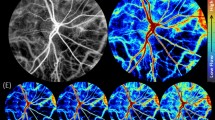Abstract
The Retinal Functional Imager (RFI) is a novel method for assessing retinal blood flow (RBF) velocity. The purpose of this study was to evaluate RBF velocities in normal human retinas using the RFI. RBF velocity measurements were performed in normal subjects using the RFI (Optical Imaging Ltd., Rehovot, Israel) at the Retina Center of The New York Eye and Ear Infirmary, New York, USA. Using proprietary software processing, the characteristics of the RBF were visualized and measured. The study population comprised fifty-four eyes of 27 normal subjects (20 male and 34 female). The average arterial blood flow velocity was 4.6 ± 0.6 mm/s in males and 4.8 ± 0.7 mm/s in females (the difference was not statistically significant, p value = 0.27). The average venous blood flow velocity was 3.8 ± 0.5 mm/s in males and 3.6 ± 0.4 mm/s in females (the difference again was not statistically significant, p value = 0.11). The average arterial blood flow velocity was 4.8 ± 0.5 mm/s in the right eye and 4.6 ± 0.7 mm/s in the left eye. The average venous blood flow velocity was 3.7 ± 0.4 mm/s in the right eye and 3.6 ± 0.3 mm/s in the left eye. Venous and arterial blood flow velocities were found to be faster in the right eye than in the left eye in our sample, but the differences were not statistically significant (p value = 0.53 and 0.33, respectively). This is the first report of quantification of the RBF using the RFI. The RFI appears to be an effective tool in quantitative evaluations of RBF velocities. The values from the study constitute a normative database which can be used to evaluate and compare eyes with known or suspected pathology.

Similar content being viewed by others
References
Horio N, Clermont AC, Abiko A et al (2004) Angiotensin AT 1 receptor antagonism normalizes retinal blood flow and acetylcholine-induced vasodilation in normotensive diabetic rats. Diabetologia 47:113–123. doi:10.1007/s00125-003-1262-x
Hata Y, Clermont A, Yamauchi T et al (2000) Retinal expression, regulation, and functional bioactivity of prostacyclin-stimulating factor. J Clin Invest 106(4):541–550. doi:10.1172/JCI8338
Kurioka Y, Inaba M, Kawagishi T et al (2001) Increased retinal blood flow in patients with Graves’ disease: influence of thyroid function and ophthalmopathy. Eur J Endocrinol 144:99–107. doi:10.1530/eje.0.1440099
Feke GT, Tagawa H, Deupree DM et al (1989) Blood flow in the normal human retina. Invest Ophthalmol Vis Sci 30:58–65
Harris A et al (2003) Atlas of ocular blood flow: vascular anatomy, pathophysiology and metabolism. Butterworth-Heinemann, Philadelphia
Wang Y, Bower BA, Izatt JA, Tan O, Huang D (2007) In vivo total retinal blood flow measurement by Fourier domain Doppler optical coherence tomography. J Biomed Opt 12:041215. doi:10.1117/1.2772871
Pournaras CJ, Rungger-Brändle E, Riva CE et al (2008) Regulation of retinal blood flow in health and disease. Prog Retin Eye Res 27(3):284–330. doi:10.1016/j.preteyeres.2008.02.002
Rechtman E, Harris A, Kumar R et al (2003) An update on retinal circulation assessment technologies. Curr Eye Res 27(6):329–343. doi:10.1076/ceyr.27.6.329.18193
Nelson DA, Krupsky S, Pollack A et al (2005) Special report: noninvasive multi-parameter functional optical imaging of the eye. Ophthalmic Surg Lasers Imaging 36:57–66
Landa G, Garcia PM, Rosen RB (2009) Correlation between retina blood flow velocity assessed by retinal function imager and retina thickness estimated by scanning laser ophthalmoscopy/optical coherence tomography. Ophthalmologica 223(3):155–161
Jensen PS, Glucksberg MR (1998) Regional variation in capillary hemodynamics in the cat retina. Invest Ophthalmol Vis Sci 39:407–414
Garcia JP Jr, Garcia PT, Rosen RB (2002) Retinal blood flow in the normal human eye using the canon laser blood flowmeter. Ophthalmic Res 34:295–299. doi:10.1159/000065600
Shimada N, Ohno-Matsui K, Harino S et al (2004) Reduction of retinal blood flow in high myopia. Graefes Arch Clin Exp Ophthalmol 242(4):284–288. doi:10.1007/s00417-003-0836-0
Iester M, Torre PG, Bricola G, Bagnis A, Calabria G (2007) Retinal blood flow autoregulation after dynamic exercise in healthy young subjects. Ophthalmologica 221(3):180–185. doi:10.1159/000099298
Wolf S, Arend O, Reim M (1994) Measurement of retinal hemodynamics with scanning laser ophthalmoscopy: reference values and variation. Surv Ophthalmol 38:S95–S100. doi:10.1016/0039-6257(94)90052-3
Rojanapongpun P, Drance SM (1993) Velocity of ophthalmic arterial flow recorded by Doppler ultrasound in normal subjects. Am J Ophthalmol 115(2):174–180
Ustymowicz A, Mariak Z, Weigele J et al (2005) Normal reference intervals and ranges of side-to-side and day-to-day variability of ocular blood flow Doppler parameters. Ultrasound Med Biol 31(7):895–903. doi:10.1016/j.ultrasmedbio.2005.03.013
Yoshida A, Feke GT, Ogasawara H, Goger DG, McMeel JW (1996) Retinal hemodynamics in middle-aged normal subjects. Ophthalmic Res 28(6):343–350
Acknowledgments
We would like to thank Darin Nelson for help with preparation of this manuscript.
Conflict of interest
No author has any conflict or commercial interest in any material or method mentioned.
Author information
Authors and Affiliations
Corresponding author
Rights and permissions
About this article
Cite this article
Landa, G., Jangi, A.A., Garcia, P.M.T. et al. Initial report of quantification of retinal blood flow velocity in normal human subjects using the Retinal Functional Imager (RFI). Int Ophthalmol 32, 211–215 (2012). https://doi.org/10.1007/s10792-012-9547-z
Received:
Accepted:
Published:
Issue Date:
DOI: https://doi.org/10.1007/s10792-012-9547-z




